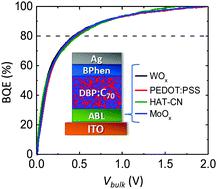当前位置:
X-MOL 学术
›
Energy Environ. Sci.
›
论文详情
Our official English website, www.x-mol.net, welcomes your
feedback! (Note: you will need to create a separate account there.)
Photogeneration and the bulk quantum efficiency of organic photovoltaics
Energy & Environmental Science ( IF 32.4 ) Pub Date : 2021-2-17 , DOI: 10.1039/d0ee03885g Kan Ding 1, 2, 3, 4 , Xiaheng Huang 2, 3, 4, 5 , Yongxi Li 2, 3, 4, 5 , Stephen R. Forrest 1, 2, 3, 4, 5
Energy & Environmental Science ( IF 32.4 ) Pub Date : 2021-2-17 , DOI: 10.1039/d0ee03885g Kan Ding 1, 2, 3, 4 , Xiaheng Huang 2, 3, 4, 5 , Yongxi Li 2, 3, 4, 5 , Stephen R. Forrest 1, 2, 3, 4, 5
Affiliation

|
We introduce a method to analyze the performance of bulk heterojunction (BHJ) organic photovoltaics (OPVs) by calculating its “bulk quantum efficiency” (BQE), a quantity related to the recombination losses within the BHJ, but not in the surrounding device layers. By applying the method to both vacuum- and solution-processed OPVs with various BHJ, buffer layers and interface layer compositions, we show that measurements of the BQE isolates the properties of the BHJ from other device layers and interfaces. We use measurements of the BQE to study various mechanisms in OPV degradation and find that for solution-processed OPVs with a ZnO cathode buffer layer, the BHJ undergoes degradation due primarily to the ZnO. By inserting a self-assembled monolayer at the interface between the buffer and the BHJ, the stability of the OPV is significantly improved.
中文翻译:

光生和有机光伏的体量子效率
我们介绍一种方法,通过计算其“体量子效率”(BQE)来分析体异质结(BHJ)有机光伏(OPV)的性能,“体量子效率”(BQE)与BHJ内但与周围器件层无关的重组损耗有关。通过将该方法应用于具有各种BHJ,缓冲层和界面层成分的真空处理和固溶处理的OPV,我们表明BQE的测量将BHJ的特性与其他器件层和界面隔离开来。我们使用对BQE的测量来研究OPV降解的各种机制,发现对于具有ZnO阴极缓冲层的固溶处理的OPV,BHJ主要由于ZnO而经历降解。通过在缓冲区和BHJ之间的界面插入自组装单层膜,可以显着提高OPV的稳定性。
更新日期:2021-02-23
中文翻译:

光生和有机光伏的体量子效率
我们介绍一种方法,通过计算其“体量子效率”(BQE)来分析体异质结(BHJ)有机光伏(OPV)的性能,“体量子效率”(BQE)与BHJ内但与周围器件层无关的重组损耗有关。通过将该方法应用于具有各种BHJ,缓冲层和界面层成分的真空处理和固溶处理的OPV,我们表明BQE的测量将BHJ的特性与其他器件层和界面隔离开来。我们使用对BQE的测量来研究OPV降解的各种机制,发现对于具有ZnO阴极缓冲层的固溶处理的OPV,BHJ主要由于ZnO而经历降解。通过在缓冲区和BHJ之间的界面插入自组装单层膜,可以显着提高OPV的稳定性。











































 京公网安备 11010802027423号
京公网安备 11010802027423号